Effect of crop residue and rainfall on the availability of pre-emergent herbicides in the soil
Author: Yaseen Khalil, Ken Flower, Kadambot H.M. Siddique, Phil Ward, Colin Piggin | Date: 28 Feb 2017
Key messages
-
Most herbicide was leached from stubble into the soil with higher rainfall amounts that occurred soon after herbicide application, and with rain in one event, rather than multiple events. However, the intensity of rainfall had no effect.
-
Less herbicide was leached after rainfall when the chemicals were applied to initially wet, compared with dry residue. This was less so for pyroxasulfone.
-
Rainfall was very effective in leaching pyroxasulfone from the residue into the soil to provide good weed control, even in heavy residues of 4 t/ha when rainfall occurred up to 14 days after herbicide application.
-
Rainfall was less effective at leaching prosulfocarb and improved weed control (from the leached chemical) only occurred with rain up to 7 days after herbicide application.
-
Rainfall was least effective in leaching trifluralin from the residue into the soil, with little improvement in ‘weed’ control when rainfall occurred 1 day after herbicide application.
-
Determine the effect of rainfall amount, intensity and timing on leaching of trifluralin, pyroxasulfone and prosulfocarb from crop residues.
-
Investigate the effect of amount of crop residue and its moisture content on retention and leaching of trifluralin, pyroxasulfone and prosulfocarb.
Aims
- Determine the effect of rainfall amount, intensity and timing on leaching of trifluralin, pyroxasulfone and prosulfocarb from crop residues.
- Investigate the effect of amount of crop residue and its moisture content on retention and leaching of trifluralin, pyroxasulfone and prosulfocarb.
Method
A series of experiments were carried out to investigate how much herbicide was intercepted by wheat residue and retained following simulated rainfall. The experiments tested different crop residue treatments (amount, moisture condition) and simulated rainfall conditions (amount, timing, intensity) on retention and leaching of three commonly used pre-emergent herbicides in southern Australia (trifluralin, prosulfocarb, pyroxasulfone). Bioassays, using annual ryegrass (Lolium rigidum) and cucumber (Cucumis sativus), were developed to assess the activity/availability of herbicide in the soil.
For all experiments, there was an untreated control and the rates of herbicide were 960, 2000 and 102g a.i. ha-1 for trifluralin, prosulfocarb, and pyroxasulfone respectively. In these experiments, four petri dishes, each with 50 g of dry soil, were placed onto plastic seedling trays, then the trays and petri dishes were covered by crop residue and sprayed with herbicide. In all experiments the data shown in the figures are from bio-assaying the soil in petri dishes. All bars in the graphs show the shoot length of the bioassay species as percentage of the untreated control. The results presented are for ryegrass, except for pyroxasulfone where both ryegrass and cucumber are shown, as this herbicide killed most of the ryegrass. In first experiment, the trays covered with wheat residue equivalent to 4t ha-1. Then, simulated rainfall was applied with four amounts (0, 5, 10, or 20mm), three different intensities (5, 10, or 20mm hr-1) and five application times (immediately after spraying herbicide (0), 0.25, 1, 7, or 14 days after spraying herbicides). In the second experiment, the herbicides were applied over the 4t ha-1 of residue and this was followed by four simulated rainfall treatments with an amount of 20mm at 10mm hr-1 intensity: (1) no rainfall, (2) four 5mm rainfall events over two days, (3) two 10mm rainfall events over one day, (4) single 20mm rainfall event. In the third experiment, an equivalent of 4t ha-1 (measured dry) of wet or dry wheat residue was placed over plastic trays followed by the herbicide sprays, then 20mm of simulated rainfall (at the same intensity as trial two) was applied. In addition to the untreated control, another residue treatment (treated control (TC)) was added, where herbicide was sprayed but no rainfall was applied. In the fourth trial, different amounts of wheat residue representing 0, 1, 2, 4t ha-1 were placed on the trays followed by the herbicide sprays and the same 20mm of rainfall or no rainfall.
The petri dishes with soil were removed and seeds of the bioassay plants were sown and then grown under controlled light, temperature and moisture. Greater inhibition (compared with the untreated) indicated more herbicide reached the soil, either directly from the spray and/or leached from the crop residue into the soil by simulated rainfall. The experiments were conducted at The University of Western Australia facilities (31.9812° S, 115.8199° E).
Results
Generally, ryegrass was much more sensitive to the herbicides than cucumber, particularly for pyroxasulfone (Figure A vs B).
1- Rainfall effects
a) Rainfall intensity
Rainfall intensity had no significant effect on leaching of herbicide from the residue into the soil, although there was a trend for an intensity of 20mm hr-1 to leach more prosulfocarb and trifluralin than the lower intensities, but not for pyroxasulfone (data not shown).
b) Rainfall amount and timing
All rainfall amounts from 5 to 20mm over the wheat residue leached the herbicides into the soil. Generally, increased amounts of rainfall leached more herbicide, although there were few differences between 10 and 20mm (Figures A–D). Also, most leaching of herbicide into the soil (greater inhibition) occurred when simulated rainfall was applied over the residue immediately after herbicide application (day 0).
The herbicides responded differently to the interaction between rainfall amount and timing (Figures A–D). Leaching of pyroxasulfone from the residue, along with improved control of the bioassay species (compared with no rainfall), still occurred with rainfall 14 days after herbicide application (Figures A and B). However, for prosulfocarb, there was no detectable leaching 14 days after herbicide application (Figure C). The trifluralin results were more variable although there appeared to be little leaching of chemical when rainfall occurred beyond 1 day from herbicide application, perhaps because the herbicide was volatilised/degraded rapidly on the stubble and little remained (Figure C).

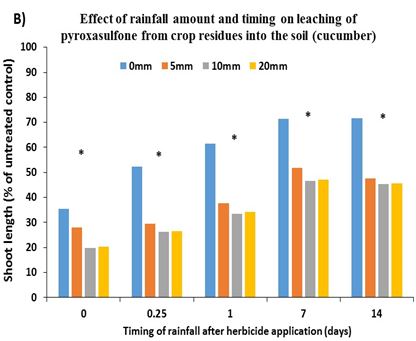

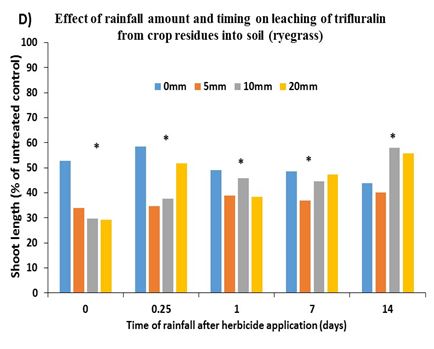
Overall, the positive effect on weed control of rainfall leaching herbicide from heavy stubble (4 t/ha) into the soil, even a few weeks after application, appeared to be greatest with pyroxasulfone and least with trifluralin. In the field other factors would need to be considered, such soil moisture activating the herbicide and also high rainfall leaching the herbicide too far down into the soil profile. Also, in the case of trifluralin, soil thrown onto the stubble may interact with the herbicide affecting its longevity.
b) Multiple rainfall events
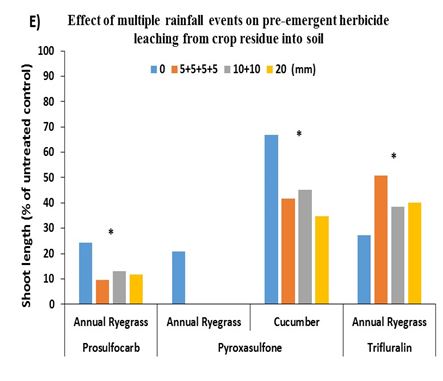
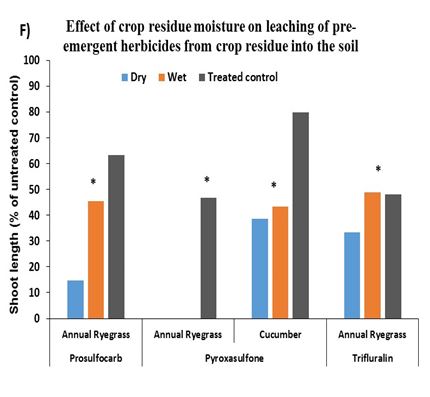
2- Crop residue effects
a) Residue moisture condition
When the herbicides were sprayed onto residue that was already wet, less chemical leached into the soil after subsequent rainfall, compared with herbicide sprayed onto dry residue (Figure F). These differences were greatest for prosulfocarb and trifluralin and less so for pyroxasulfone. This is possibly due to greater volatilisation/loss of herbicide from spraying the chemical onto wet residue compared with dry residue.
b) Residue amount
In the absence of rainfall, increased residue amount reduced the ‘weed’ control efficacy of all the herbicides, with 4 t/ha being markedly worse than 1–2 t/ha. All herbicides killed the ryegrass with no stubble present (Figure G).
Rainfall, which leached herbicide from the residue into the soil, improved the efficacy of the herbicides for all stubble rates, but especially with 4 t/ha. For prosulfocarb, all the ryegrass was killed after rainfall leaching with 1 t/ha of residue, whereas for pyroxasulfone all ryegrass was killed even with 4 t/ha of residue. For trifluralin, 100% kill was not achieved with any rate of stubble present, although there was >70% shoot inhibition with up to 2 t/ha stubble (Figure G).
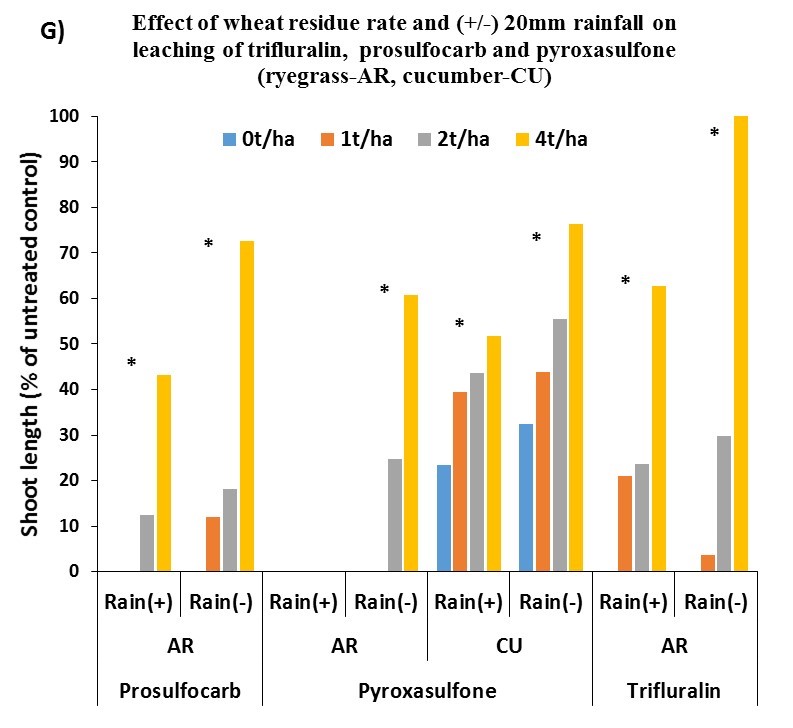
Conclusion
Rainfall effects
Some of the herbicide leached from the residue with as little as 5mm of rainfall, although higher rainfall amounts generally leached more herbicide from the residue. The sooner the rainfall occurred the greater the amount of herbicide leached. There were no differences between rainfall intensities. Multiple rainfall events (four events of 5mm over two days) leached slightly less intercepted herbicide off the wheat residue than a single event of 20mm.
Herbicide effects
Rainfall was very effective in leaching pyroxasulfone from the residue into the soil, even in heavy residues of 4 t/ha when rainfall occurred 14 days after herbicide application. Rainfall leached less prosulfocarb and this only occurred with rain up to 7 days after application of the chemical. Trifluralin leached the least, with little improvement in ‘weed’ control when rainfall occurred 1 day after herbicide application.
Residue effects
Less herbicide leached from the crop residue after rainfall, when the chemicals were applied to initially wet residue, rather than dry residue. Increased amounts of wheat residue intercepted more herbicide, with a large increase in interception from 2 to 4 t/ha. However, 100% ryegrass kill was achieved with pyroxasulfone after rainfall, even with 4 t/ha.
Acknowledgments
We acknowledge funding from Australian Centre for International Agricultural Research (ACIAR) John Allwright Fellowship (JAF) providing the scholarship, UWA Institute of Agriculture and School of Plant Biology providing research operating funds. We also acknowledge Australian Herbicide Resistance Initiative (AHRI) and Syngenta Australia for their support and providing herbicides.Was this page helpful?
YOUR FEEDBACK
